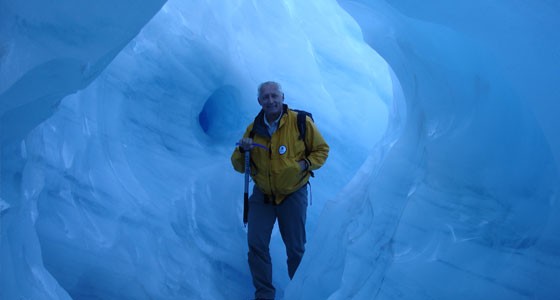
Meeting his hero, Sir Edmund Hillary.
It was a great moment. A private meeting with Sir Edmund Hillary and Lady June Hillary in December 2002, in Wellington, New Zealand. “I was very impressed by his gaze and his stature, but mainly by the realization that I was in the presence of the first person to look out over the horizon from the world’s highest summit and write a new page in history. A modern-day Christopher Columbus.” It was a warm exchange and an unforgettable experience. Sir Edmund wrote the preface to the English version of Bernard’s book, Aniu – From Snowflake to Iceberg.
[cycloneslider id=”nouvelle-zelande-2″]
New Zealand is first and foremost the land of Sir Edmund Hillary, but also a country of winding, twisting, marvellous glaciers descending from the mountains on the South Island. Nature can be powerful and calm at the same time. These glaciers plunging into the forest constantly beckon.
South Island is slightly larger than North Island, and its mountain range, extending almost all the way along the island, has 233 summits above 2,300m. Low-altitude vegetation on the eastern slopes contrasts with magnificent rainforests on the western side. With its prairies, lakes and glaciers, New Zealand is a true paradise for hikers and climbers.
Mount Cook (3,754 m) National Park, one of many, offers a variety of routes and climbs. This impressive mountain range emerged quickly, in just two million years, and continues to rise 10mm a year.
Glaciers can be nearly 30km long and 3km wide, and as much as 600m thick. The Franz Josef Glacier is particularly interesting to explore, since it ends in an icefall, exposing its inner splendours.
The limpidity of this bluish glacier is especially remarkable in the caves, holes, cracks and crevasses. Once again, you realize the power of glaciers, their patience in carving out valleys. But the effects of global warming are also visible, as all the glaciers in New Zealand are shrinking measurably. The rocky cliffs beside the glaciers are marked with striations, each one serving as a calendar and clearly indicating just how much the glaciers have retreated.
